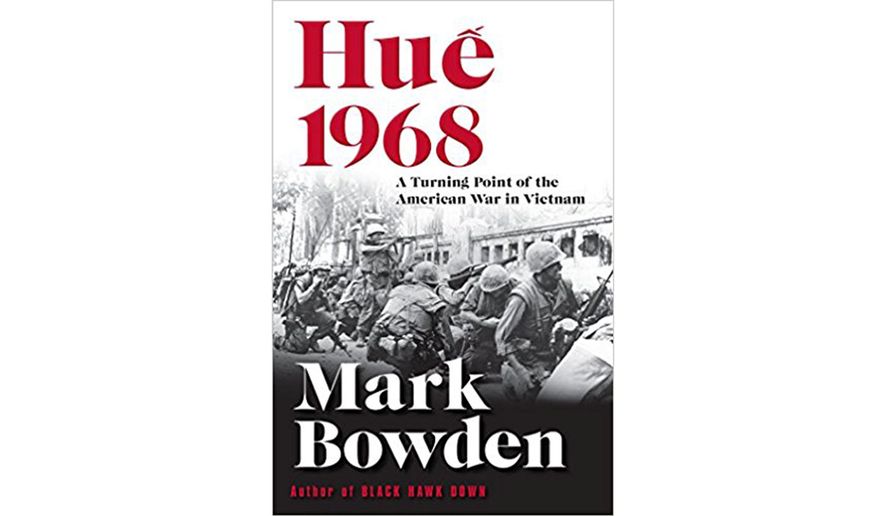
The horror of urban combat in Vietnam
A few years ago, I was lecturing my students on strategic surprise. I asked each of them to write paragraph on how surprise was used at Hue in 1968 based on what they knew of it. With few exceptions, the reply was that Hue was the battle where the Viet Cong won the war in a general uprising. These were graduate students, and their woeful knowledge of the Vietnam War was gained through the state of education in our high schools and undergraduate college programs. Their ignorance is more a comment on the “liberal” in liberal arts than in any defect in my students. Today, we are chronologically as far removed from Vietnam as my generation was from World War I in 1968; and its lessons are in danger of being lost. Mark Bowden tries to remedy this with his excellent new book, “Hue 1968.”
Mr. Bowden points out that the Tet Offensive campaign, of which Hue was the major battle, was a strategic surprise that ranks along with Pearl Harbor and Sept. 11 as a colossal American intelligence failure. However, it was not planned and fought by peasant Viet Cong (VC) guerrillas. It was planned by the North Vietnamese general staff and political leaders in Hanoi and fought largely by regular regiments of the North Vietnamese Army (NVA); the VC were relegated to being scouts, guides, suicide sappers, and cannon fodder.
The NVA and Viet Cong lost every tactical engagement and failed to achieve their primary objective, a popular uprising that would topple the South Vietnamese government and force the Americans out of the war. However, Tet was the turning point of the war because America’s leaders were discredited by the surprise and lost the confidence of a significant portion of the American public. Tet ruined Lyndon Johnson’s presidency. There was no “light at the end of the tunnel.” Although the last U.S. bombs would not fall until 1973, the North Vietnamese had irretrievably gained the psychological advantage.
Mr. Bowden covers the overall planning for Tet to set context, but concentrates on the battle for Hue City in hour by hour detail as it represents the degree to which America leaders from the White House down to the tactical levels saw their assumptions and narratives shattered. Until Tet, the NVA and VC had generally waged guerrilla tactics and operated in battalion strength only rarely.
The Americans knew a big attack was coming, but they thought it would be at Khe Sanh in a remote area where the Americans hoped to lure the NVA into a climatic big battle, which would be the reverse of Dien Bien Phu where the NVA had crushed the French in 1954. The reality was that the planners in Hanoi used Khe Sanh as a “matador’s cape” to mask their preparations for a nationwide offensive. When U.S. general officers near Hue learned that the enemy had seized much of the city, they thought it was a few hundred commandos and ordered a Marine battalion to clean them out. The Communists had infiltrated whole regiments from the north and the Marines were initially attacking into a dug-in force that outnumbered them by at least 10-1.
What followed was an epic urban battle in which the Marine Corps (supported by what Army troops could be scraped up) eventually prevailed by dint of superior supporting arms and pure grit on the part of companies, platoons and squads. Mr. Bowden was a reporter before he became an author, and he uses a reporter’s concise style to tell both sides of the story from the president of the United States to a teenage VC scout/guide. Just about everyone in the battle went in with false assumptions, and came out with an altered sense of the horror of urban combat.
Many of the Marine characters such as Ernie Cheatham and Ron Christmas became legends of the corps and as senior officers urged all the services to get better at urban combat. Their efforts paid off in places like Ramadi and Fallujah from 2003-04. Unfortunately, we have been less adept at teaching our friends and allies the lessons of urban warfare. The battle for Mosul in Iraq looks depressingly like Hue, albeit on a much larger scale.
Mr. Bowden has done a superb job of telling the story as he did with “Blackhawk Down.” One can sometimes get lost in the plethora of Vietnamese names, but as in war the individuals are less important than lessons imparted; and in Hue, there were lessons aplenty.
No comments:
Post a Comment